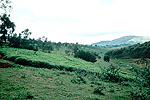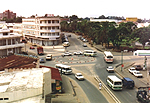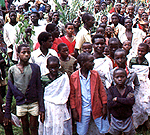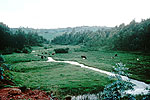|
Economy:

Tea Farming
©2001-2002: Africa Focus
|

Bujumbura
©2002: Tourist Office
|
|
|
Burundi is an isolated country without any mineral resources and mostly subsistence farming. It has the lowest rate of urbanisation in the world, with only 2,2% of the population living in towns. The population density is very high, and nearly every bit of land is under cultivation. A great variety of crops can be grown due to the fertile soil and favourable climate - strawberries, lettuce and tomatoes are grown throughout the year, but they are used exclusively by the Europeans. The economy has been badly hit by coups, insecurity and sanctions, and the country is dependent on international humanitarian aid. 40% of government expenditure is on the military. The country has stopped paying interest on its national debt. Burundi was the world’s 5th producer of bananas, 6th of manioca and sweet potatoes, and 16th of legumes. Cotton and coffee were the main exports.
|
History:
|
Colonisation did not really change the division of labour and power between the two main ethnic groups, the Tutsi, herders and partoralists who form a sort of aristocracy, and the Hutu, sedentary pastoralists who are politically and culturally dominated by the Tutsi, but outnumber them and constitute 84% of the population. Both Rwanda and Burundi share the same two ethnic groups, but in Burundi the Hutu majority did not rise to power after independence. Burundi gained independence from Belgium in 1962 and has been governed since then by a succession of minority Tutsi governments. The country was governed by constitutional monarchy until 1966 when Prime Minister Captain Michel Micombero declared a republic. However plots and attempts on his life followed, and in 1965 new elections were held and won by the Hutu’s. Shortly after this, in 1966, there was a coup d’etat, and Colonel Micombero announced that the country would now be a republic. The single party, was dominated by the Tutsi’s, and soon civil war broke out.
|
|

©2002: Tourist Office
|

©2002: Africa Focus
|
|
In 1972 the Hutu’s attempted a coup d’etat, and 100,000 of them were killed in reprisal. There has since been a succession of coup’s, with ethnic tensions being worsened by the wars in Ruanda and Zaire. In 1976 Micombero was overthrown by Colonel Jean Baptiste Bagaza, who in turn was deposed by Major Pierre Buyoya in 1987. Burundi’s attempt at a transition to democratic civilian rule has been impeded since the early 1990s. The 1993 presidential elections brought Melchior Ndadaye to power, defeating the incumbent, Major Buyoya. However, President Ndadaye was killed in a coup attempt in 1994. His successor, Cyprien Ntaryamira, died after two months in office when the plane carrying him and the Rwandese president was shot down over Kigali. Major Pierre Buyoya reclaimed power through a coup d’état in 1996. He abolished the constitution, suspended the national assembly, and prohibited political parties, triggering the imposition of economic sanctions by neighboring countries. A peace process aimed at reaching a negotiated settlement to the crisis included: -domestic efforts that have already led to a transitional constitutional act and a new government in June 98; and -the Arusha process, facilitated by President Nyerere, which has initiated a series of all inclusive rounds of negotiation since June 98. The sanctions were eased in April 1997 to allow emergency assistance to reach vulnerable groups in Burundi. Agreement was reached on a cease-fire in June 1998 and rules of procedure were adopted in July.
The current president, Buyoya, is a Tutsi, while there has been a resurgence of rebel activity since 1999. Buyoya started an internal peace process in August 1996, with a 'National Debate' among Hutu and Tutsi notables. In light of Government’s engagement into negotiations with other parties to the conflict, and recognizing progress realized through the internal and external (Arusha) peace processes, the sanctions were suspended on January 23, 1999. In September 1999, rebel attacks reached into Bujumbura city. Regional leaders, led by Tanzanian President Julius Nyerere, agreed in July 1996, to impose sanctions on Burundi until it unbanned political parties, restored parliament and started negotiations with other parties to the conflict in Burundi. Sanctions were lifted in 1999 after important reforms were made. Nelson Mandela took over as leader of the Arusha Peace Process in December 1999.
Enabling us to improve the quality of the content, if you have additonal information, remarks or suggestions, please share it with us by e-mail.
BRUSSELS/BELGIUM: 30 April 2009:
BRUSSELS AIRLINES flies Africa

In 2002 SN Brussels Airlines was created to continue in the
steps of the two companies Sabena and DAT, who between them had an unequalled safety record. BRUSSELS AIRLINES was created
following the merger of SN Brussels Airlines (SNBA) and Virgin Express. On 12 April 2005, SN Airholding, the company behind SNBA,
signed an agreement with Richard Branson, giving it control over Virgin Express. On 7 November 2006, the new name,
Brussels Airlines, was announced at a press conference at Brussels Airport. Brussels Airlines began operations on 25 March 2007.
On September 15, 2008 it was announced that Lufthansa will acquire a 45% stake in Brussels Airlines with an option to acquire
the remaining 55% from 2011. As a part of this deal Brussels Airlines will join Star Alliance. On March 13, Brussels Airlines
announced that the airline will codeshare all their flights to Germany with Lufthansa. The codeshare agreement will start from March 29.
This new step is part of the integration of Brussels Airlines into the Star Alliance network. Brussels Airlines becomes a
Star Alliance member in 2009.
From 26 April 2002 SN Brussels Airlines opened frequent Africa connections and presently BRUSSELS AIRLINES serves safe and reliable flights to:
ANGOLA (Luanda) - BURUNDI (Bujumbura) - CAMEROON (Douala & Yaoundé) - CôTE D'IVOIR (Abidjan) - DEMOCRATIC REPUBLIC OF THE CONGO
(Kinshasa) - THE GAMBIA (Banjul (Banjul) - GUINEA (Conakry) - KENYA (Nairobi) - LIBERIA (Monrovia) - RWANDA (Kigali) -
SENEGAL (Dakar) - SIERRA LEONE (Freetown) - UGANDA (Entebbe)
For further information click here and please tell them we sent you!
BUJUMBURA, 6 October 2001: Eleven people were killed this week and some 20,000 fled their homes when gunmen attacked a town in northwest Burundi. "Rebels in military uniform burst into a bar and started shooting, killing about 10 people, prompting the army to respond," said the administrator of Rugazi commune, Felicien Ntahorwamira. The incident took place Thursday in the town of Muzinda in Bubanza province. During the fighting that followed "Muzinda's entire population, some 3,500 households, fled the town," for the nearby settlement of Mpanda, added the administrator. "Houses were still burning on Friday morning and that afternoon there was gunfire," he added. Meanwhile clashes 17 kilometers (10.5) miles south of Bujumbura, in Kanyosha commune, prompted the closure of Route Nationale 7. "There was fighting in Raro and Nyabiraba - traffic was
stopped as a security measure," said an official, explaining that more than 100 busses lorries and private cars were parked in Musaga at the southern entrance to Bujumbura.
"It was medium level fighting, the biggest weapons employed being rocket-launchers and machine guns," rebel spokesman Anicet Ntawuhiganayo said. Hutu rebels have been fighting a regime and army dominated by Burundi's Tutsi minority since 1993, and some 200,000 people have been killed in the war. A protacted series of negotiations aimed at distributing power more equitably between the Tutsis and the Hutu majority has made
some headway -- a transitional government is due to get off the ground next month -- but a ceasefire with the ever-active rebels remains elusive.
Last update: 30 April, 2009
|

